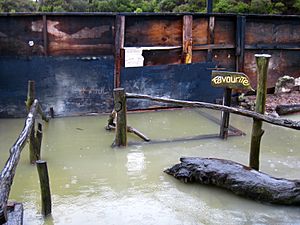Ngawha Springs facts for kids
Quick facts for kids
Ngawha Springs
|
|
|---|---|
| Country | New Zealand |
| Region | Northland Region |
| District | Far North District |
| Ward | Kaikohe/Hokianga |
| Electorates |
|
| Area | |
| • Total | 3.67 km2 (1.42 sq mi) |
| Population
(June 2023)
|
|
| • Total | 180 |
| • Density | 49.0/km2 (127/sq mi) |
Ngawha Springs (Māori: Ngāwhā) is a small place in Northland, New Zealand. It's famous for its natural hot water springs. Ngawha is about five kilometers east of the town of Kaikohe. The Māori name Ngāwhā means "boiling spring," which makes a lot of sense!
People believe that bathing in these warm waters can be good for your health. The steam from these springs is also used to create electricity. This happens at the Ngawha geothermal field's power station nearby.
Ngāwhā is also home to Ngāwhā Marae and its meeting house, E Koro Kia Tutuki. This is a special traditional meeting place for several local Māori groups. These groups are called hapū, and they are part of the larger Ngāpuhi tribe. The hapū include Ngāti Kiriahi, Ngāti Mau, Ngāti Rangi, Te Uri Hoatau and Te Uri Taniwha.
Contents
Relaxing Hot Springs
The main Ngāwhā Springs complex has many pools for everyone to enjoy. There are 16 public pools and 8 private pools. The water temperatures vary quite a bit. Some pools are around 32°C (89°F), which is pretty cool. Others, like the "Favourite" and "Doctor" pools, are extremely hot!
The complex was updated in 2020–2021. This included building a new area with changing rooms, a cafe, and a ticket office. There are also rooms for health experts. Before this, the last big upgrade was in the late 1970s.
There was another spa nearby called Ginns Ngawha Spa. It closed in 2015. However, it reopened for a short time while the main Ngāwhā Springs was being updated. Both spa complexes are managed by the Parahirahi Ngāwhā Waiariki Trust.
Who Lives in Ngāwhā Springs?
Ngāwhā Springs is a small rural settlement. It covers an area of about 3.67 square kilometers. In 2018, about 147 people lived here. This means there were about 40 people living in each square kilometer.
Population Changes Over Time
The number of people living in Ngāwhā Springs has changed a bit over the years:
- In 2006, there were 132 people.
- In 2013, the population was 123 people.
- By 2018, it grew to 147 people.
This shows an increase of 24 people since 2013. It's also an increase of 15 people since 2006.
Community and Age Groups
In 2018, there were 54 households in Ngāwhā Springs. There were 69 males and 78 females. The average age of people living here was 33.8 years. This is a bit younger than the national average of 37.4 years.
Here's a look at the different age groups:
- About 24.5% of the people were under 15 years old.
- About 16.3% were between 15 and 29 years old.
- About 46.9% were between 30 and 64 years old.
- About 12.2% were 65 years or older.
Different Backgrounds
People in Ngāwhā Springs come from different backgrounds:
- About 30.6% were European/Pākehā.
- A large number, about 83.7%, were Māori.
- Smaller groups included 2.0% Pacific peoples and 2.0% Asian people.
- About 4.1% identified with other ethnicities.
It's important to remember that people can identify with more than one ethnicity.
Beliefs and Religions
When asked about their religious beliefs in the census:
- About 49.0% said they had no religion.
- About 28.6% were Christian.
- About 8.2% followed Māori religious beliefs.
- About 8.2% had other religions.


